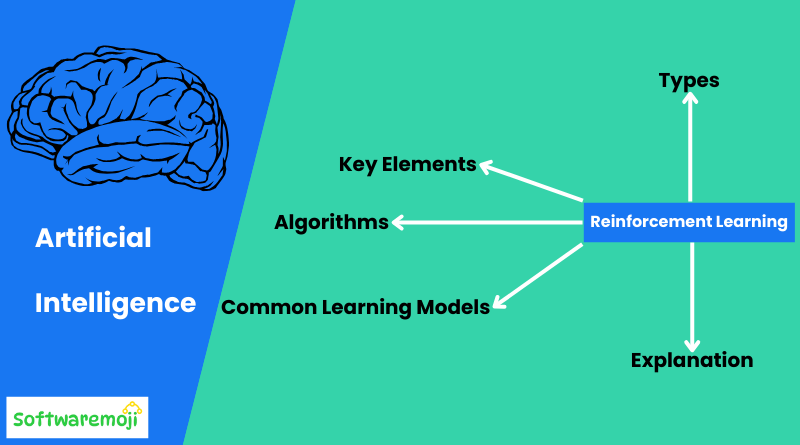
👉Comprehensive Guide to Reinforcement Learning:-
Reinforcement Learning (RL) is a cutting-edge subfield of Artificial Intelligence (AI) and Machine Learning (ML) that teaches agents (software programs or robots) how to make decisions by interacting with an environment. The goal? Maximize a reward by taking the best possible actions in different scenarios.
👉Comprehensive Guide to Reinforcement Learning What is Reinforcement Learning?
At its core, Reinforcement Learning involves an agent interacting with an environment in order to learn how to achieve specific objectives. The agent makes decisions and receives feedback in the form of rewards or penalties. This feedback loop helps the agent understand which actions lead to the most beneficial outcomes.
👉Comprehensive Guide to Reinforcement Learning Key Elements of Reinforcement Learning:
Reinforcement Learning is built on several essential components, each playing a unique role in how an agent learns:
- Agent: The decision-maker or learner in the system.
- Environment: The world in which the agent operates.
- State (s): The current condition or situation in which the agent finds itself.
- Action (a): The choices available for the agent to make in a given state.
- Reward (R): The feedback or feedback signal received after taking an action in a state.
- Policy (π): The strategy that the agent follows to determine the best actions.
- Value Function (V): Measures the long-term benefit of being in a particular state, considering future rewards.
👉Reinforcement Learning Algorithms:
Reinforcement Learning uses three main types of algorithms to solve problems and guide decision-making processes:
- Value-Based Methods:
- Focus on evaluating the value of different actions and states to maximize long-term rewards.
- A common algorithm used is Q-learning, where the agent learns the value of state-action pairs.
- Policy-Based Methods:
- Directly optimize the policy (action-selection strategy) to achieve maximum rewards.
- Can be deterministic (same action for a given state) or stochastic (probabilistic action selection).
- Model-Based Methods:
- Build a model of the environment to simulate outcomes and plan actions accordingly.
- Helps predict and adapt to future states of the environment more efficiently.
👉Types of Reinforcement Learning: Positive vs Negative:
- Positive Reinforcement:
- Strengthens the behavior by rewarding the agent for performing a desirable action.
- For instance, giving a treat to a dog when it performs a trick.
- Negative Reinforcement:
- Encourages the agent to perform an action by removing an unpleasant stimulus.
- For example, stopping an annoying sound when a task is completed.
Both types of reinforcement can be used to optimize behavior, but too much reinforcement (positive or negative) may lead to over-optimization, making the agent overly focused on specific actions without considering the broader environment.
👉Common Learning Models: Markov Decision Process & Q-Learning:
- Markov Decision Process (MDP):
- A mathematical framework for modeling decision-making in situations where outcomes are partly random and partly under the control of the decision-maker.
- Q-Learning:
- A value-based algorithm that helps an agent choose the best action by learning the value of different actions over time, based on rewards received.
👉Applications of Reinforcement Learning:
Reinforcement Learning has several real-world applications, including:
- Robotics: Industrial robots use RL to learn optimal motion strategies.
- Self-Driving Cars: RL helps autonomous vehicles navigate by continuously learning from their environment.
- Business Strategy: RL can optimize strategies for stock trading, marketing, and resource management.
- Healthcare: Personalizing treatment plans and optimizing medication administration schedules.
- Gaming: AI in games like Chess or Go uses RL to improve strategies and performance.
👉Why Use Reinforcement Learning?
Reinforcement Learning excels when the problem requires sequential decision-making, where actions taken today affect future outcomes. It’s particularly useful when an agent needs to learn from trial and error and maximize cumulative long-term rewards.
👉When NOT to Use Reinforcement Learning:
While RL is powerful, it isn’t always the best option. Consider avoiding RL when:
- You have enough labeled data for supervised learning.
- The problem involves large action spaces, making RL computationally expensive.
- The environment is too complex or lacks sufficient feedback for learning.
👉Challenges in Reinforcement Learning:
While promising, RL faces challenges such as:
- Feature/Reward Design: Creating an effective reward structure is complex but essential.
- Learning Speed: Some RL algorithms can take a lot of time to converge.
- Partial Observability: Real-world environments may not provide the complete information the agent needs.
- Overfitting: Over-optimization can lead to poor generalization in real-world tasks.
Understanding Backpropagation in Neural Networks:-
👉Comprehensive Guide to Reinforcement Learning Conclusion:
Reinforcement Learning offers powerful solutions for autonomous decision-making systems. By understanding its key components, algorithms, and types, businesses can unlock opportunities for improved automation, robotics, and data-driven strategies. However, careful consideration of the environment, feedback mechanisms, and action space is essential to implementing RL successfully.
